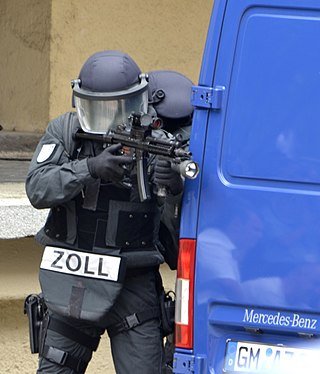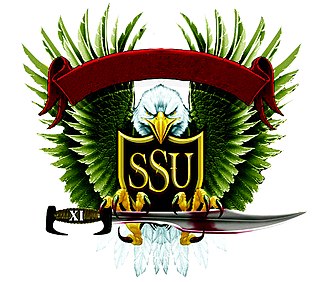
The Special Tactics and Rescue (STAR) is an elite tactical unit of the Singapore Police Force responsible for conducting counter-terrorism and hostage rescue operations in Singapore. It is under operational control of the SPF's Special Operations Command.

The Police Tactical Unit (PTU) is a paramilitary specialist unit of the Singapore Police Force and comes under the direct command of the Special Operations Command. Based in Queenstown, it is the main anti-rioting and disaster-management unit of the police force. They are also called upon to handle cases of serious crime in progress, particularly cases involving firearms. From 2004, PTU officers also presented greater public prominence when they conducted patrols in public areas, such as at Orchard Road, Holland Village and Serangoon Gardens Estate, partly as a response to greater terrorism concerns.
Spezialeinsatzkommando are police tactical units of each of the 16 German State Police forces. Along with the Mobiles Einsatzkommando (MEK), Personenschutzkommando (bodyguards), and the Verhandlungsgruppe, they are part of the police Spezialeinheiten of each state.

A prison officer (PO) or corrections officer (CO), also known as a correctional law enforcement officer or less formally as a prison guard, is a uniformed law enforcement official responsible for the custody, supervision, safety, and regulation of prisoners. They are responsible for the security of the facility and its property as well as other law enforcement functions. Most prison officers or corrections officers are employed by the government of the jurisdiction in which they operate, although some are employed by private companies that provide prison services to the government.
The CTOE - Centro de Tropas de Operações Especiais, based in Lamego, is a unit of the Portuguese Army with the mission of instructing troops in unconventional warfare and counter-terrorism. Until 2006, it was known as CIOE - Centro de Instrução de Operações Especiais.
The Security Operations Group (SOG) is a unit of elite corrections officers of Corrective Services NSW, Australia formerly known as the Hostage Response Group (HRG).

The Emergency Response Unit (ERU) is the police tactical unit of the Garda Síochána, Ireland's national police and security service. The unit was a section of the forces' Special Detective Unit (SDU), under the Crime and Security Branch (CSB) until 2017, when the Special Tactics and Operational Command was created to take over its operational duties alongside Armed Support Units.

The Singapore Prison Service (新加坡监狱署) or SPS is a government agency of the Government of Singapore under the purview of the Ministry of Home Affairs. The service runs 14 prisons and drug rehabilitation centres in Singapore. Its responsibilities encompass the safe custody, rehabilitation and aftercare of offenders, and preventive education.

The Special Actions Detachment or DAE is the tier one special force maritime unit of the Portuguese Navy. It is part of the Portuguese Marine Corps. Raised in 1985, the DAE is one of the smallest special forces units within the Portuguese Armed Forces. It is responsible for conducting air-sea rescue, amphibious reconnaissance, amphibious warfare, black operation, bomb disposal, CBRN defense, coastal raiding, counterterrorism, direct action, executive protection, hostage rescue, irregular warfare, ISTAR, long-range penetration, JTAC, manhunt high-value target, maritime sabotage, mountain rescue, naval boarding, operation behind high risk enemy lines, special operations, special reconnaissance, tracking targets, underwater demolition, unconventional warfare, other missions in support of Portuguese and NATO armed forces. DAE's mission and training are similar to their American counterparts DEVGRU and the British SBS. DAE often trains with them alongside other SMU counter-terror units.

A correctional emergency response team is a team of specially trained prison officers tasked with responding to disturbances, riots, cell extractions, mass searches, and other situations in prisons that are likely to involve uncooperative or violent prisoners.
Special Operations Response Teams are a group under the US Federal Bureau of Prisons (BOP), a component of the US Department of Justice. The BOP is responsible for maintaining the custody of anyone convicted of committing a federal crime. To achieve this goal, the BOP maintains a number of correctional facilities, which are divided into six regions, throughout the US. These facilities house approximately 211,195 inmates of varying security levels. Facilities are designated as either minimum, medium, maximum, or the most recent addition, super max.
Reinforced Regional Task Force, prior to 2015 officially known as Piketen is a regional special operations asset of the Swedish Police Authority, similar to SWAT type units in the United States. RRTF is called upon when situations occur that are too dangerous for ordinary police to handle such as hostage situations, serving high-risk arrest warrants and confronting armed criminals. RRTF units are based in Stockholm, Gothenburg and Malmö.
Corrective Services NSW (CSNSW) is an executive agency of the Government of New South Wales, Australia. CSNSW is responsible for the state's prisons and a range of programs for managing offenders in the community. The state has 36 prisons, 33 run by CSNSW and three privately operated. The agency traces its origins back to 1788, when New South Wales was founded as a penal colony.

The ARAS or Lithuanian Police Anti-terrorist Operations Unit ARAS is the tier one police tactical unit of the Lithuanian Police Force and was established in 1991. At first, ARAS's main purpose was to counterterrorism and hostage rescue crisis management, providing security VIP, and suppress organized crime groups that were widely operating in Lithuania in 1990s. In addition, they handled support crowd control and riot control.
The Trup Tindakan Cepat, or TTC, is an elite counter terrorism unit within the Malaysian Prison Department.

The Zentrale Unterstützungsgruppe Zoll (ZUZ) is the police tactical unit of the German Customs Service (Bundeszollverwaltung) and subordinate to the German Customs Investigation Bureau.

The JMF Elite Forces is the only tier one special forces unit in Malaysia placed under the responsibility of the Royal Johor Military Force (JMF) with amphibious reconnaissance, black operation, counterterrorism and hostage rescue crisis management, naval boarding, respond quickly in emergency situations, support search and rescue in hazardous environments, special warfare in any incidents involving the state of Johor, and the mandate of providing security and protection to the Royal Family of Johor.
The Specialist Protective Services (SPS) is a highly trained police unit of the Australian Federal Police (AFP) consisting of a range of teams capable of deploying at short notice in order to undertake a variety of specialist policing tasks. SPS predominantly consist of sworn police officers, based in Canberra, Australian Capital Territory (ACT), who are capable of resolving high risk planned and emergency policing operations; both domestically and internationally.

The Special Service Unit (SSU) is a component of the California Department of Corrections and Rehabilitation (CDCR). It functions as the special operations division of CDCR. The unit is staffed by special agents assigned to field offices throughout the state. Although the special agents work for CDCR, they are neither correctional officers nor parole agents. SSU special agents are full-time peace officers per California Penal Code Section 830.2. This makes agents more akin to state police officers than to correctional officers.










